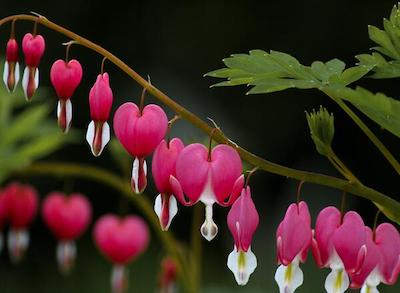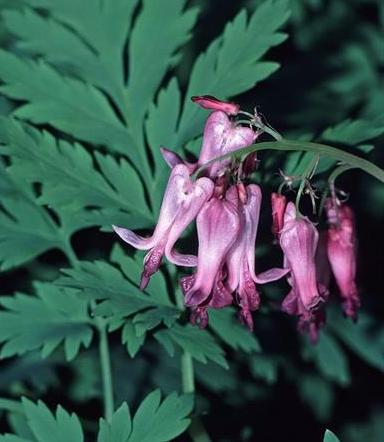Unique and Beautiful Bleeding Heart
by Carolyn R. Casey, Fairfax Master Gardener
 There is nothing like a Bleeding Heart, which makes a spectacular addition to your garden. Bleeding heart Lamprocapnos spectabilis is an herbaceous perennial with beautiful, unique heart shaped flowers and green fern-like foliage that has three leaflets. It is an easy-care plant that flourishes in the morning sun and afternoon shade. It also likes partial shade to full shade. In cool moist conditions, it will also tolerate full sun.
There is nothing like a Bleeding Heart, which makes a spectacular addition to your garden. Bleeding heart Lamprocapnos spectabilis is an herbaceous perennial with beautiful, unique heart shaped flowers and green fern-like foliage that has three leaflets. It is an easy-care plant that flourishes in the morning sun and afternoon shade. It also likes partial shade to full shade. In cool moist conditions, it will also tolerate full sun.
Some of its common names are Asian Bleeding Heart, Japanese Bleeding Heart and Locks and Keys. It grows erect to a height of 2 to 3 feet (60 – 90 cm) and a width of 1 to 3 feet (30 – 60 cm). It can also grow as a clump or mound. It is native to Siberia, Japan, Northern China and Korea. The species name spectabilis means spectacular or showy. The common name is derived from the exerted inner petals “bleeding” from the outer heart-shaped petals. Bleeding heart is a member of the Papaveraceae (poppy) family. It used to be known as Dicentra spectabilis or Fumaria spectabilis.
Bleeding heart blooms in the spring and early summer with pink and white heart shaped flowers that are 1 to 2 inches (3 – 5 cm) long. It has raceme inflorescences with 7 to 15 flowers that dangle in a row in a one-sided horizontal raceme and end on an arching leafless stem. It has heart-shaped bracts and two inconspicuous sepals. Bleeding heart has four petals that are in opposite pairs. The outer petals are rose-red, pink to white. The inner white petals usually have red and yellow markings. It also has tongue-shaped convex inner faces and crested tips.
Its leaves are compound and alternately arranged. The leaflets are ovate, coarsely lobed or toothed. The leaves are green on top and glaucous underneath. During mid-summer, after it has finished blooming, the foliage turns yellow and drops. When your bleeding heart blooms this year, pull back the two pink petals revealing another name for this flower, Lady-In-A-Bath.
Bleeding heart has two cultivars. ‘Alba’ has white blooms and tolerates the summer heat. ‘Golden Heart’ has bright green foliage and rose-pink heart shaped flowers.
Bleeding heart produces fruit from April to June that is in an oblong capsule, 25 to 35 mm long, and contains two to eight black round and smooth seeds. It has brown to copperish stems that are thick and 23 to 36 inches (60 – 90 cm) long. The petiole is 2 to 4.5 inches (5 – 10 cm) long. This perennial likes neutral to alkaline, moist, well-drained soil containing humus. It can exist in clay, silt and sandy soil.
Bleeding heart can be propagated by division, root cutting and seed. It also self-seeds. It attracts hummingbirds and butterflies and grows in Zones 3 to 9. It resists problems from black walnut, deer, heavy shade and rabbits and does not have any serious insect or disease problems. Aphids may visit it, and slugs may feed on the leaves.
All parts of the plant are poisonous, including the flowers, fruit, leaves, roots, sap, seeds and stems. It is poisonous to people and can be a problem for cats and dogs. Symptoms of poisoning are trembling, staggering, vomiting and diarrhea. Convulsions, labored breathing and skin irritation can occur after repeated contact. Since it can cause contact dermatitis, it is recommended that you wear gloves and protective equipment when handling the bleeding heart plant.

Dicentra eximia
There is a bleeding heart that is native to eastern North America, Dicentra eximia, or fringed bleeding heart. It has a longer blooming period and fine-textured leaves. It grows a foot tall and has finely divided leaves and smaller flowers. Dicentra formosa or western bleeding heart is native to the northwest United States. These bleeding-heart varieties have a longer blooming season and retain their leaves throughout the growing season.
There is also a bleeding-heart vine Clerodendrum thomsoniae. It is from tropical west Africa. It is also known as glory bower, bagflower, bleeding glory bower, tropical bleeding heart and glory tree. It is not related to the common bleeding heart. The name comes from the flowers that appear to have a drop of red blood exuding from the heart shaped calyx.
Bleeding heart makes a wonderful addition to your garden, adapts to many environments and is eye candy for your yard. There is nothing like a Bleeding Heart. Happy gardening.
Resources
Lamprocapnos spectabilis, North Carolina Extension Gardener Plant Toolbox
Bleeding Heart, Dicentra spectabilis, University of Wisconsin-Madison
Bleeding Heart, Cornell University
Asian Bleeding Heart, Mackenzie Morton, Jim Chatfield, The Ohio State University
Bleeding Heart Vine, Clerodendrum thomsoniae, Susan Mahr, University of Wisconsin-Madison